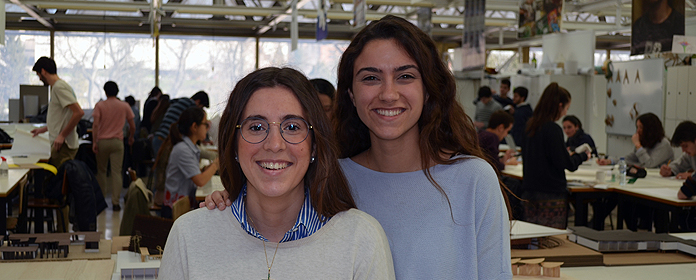2017_03_15_ARQ_proyectos_solidarios
A project for urban regeneration in informal settlements, winner of the Solidarity Project Competition
The 4th year Architecture students Beatriz Almeida Vargas and Carmen Bistuer participate in the project

The project "Urban regeneration with sustainability criteria in informal settlements. Case study: Pamplona, Lima, Peru", with the participation of Beatriz Almeida Vargas and Carmen Bistuer, 4th year students of Degree in Architecture, has won result the first Call for Solidarity Projects in Architecture, organized by Tantaka and the School of Architecture.
The project started five years ago at the department of Urbanism of the School of Architecture and tries to apply sustainable urbandesign solutions in different areas worldwide. The goal is to take this internship to neighborhoods created informally and spontaneously, and, in this specific case, to apply it to a neighborhood in Lima (Peru) named after the capital city of Pamplona, where there has been a settlement since 2004 that, due to the passage of time, has been legalized.
"Our proposal consists of regenerating this neighborhood by improving the lives of the inhabitants through sustainable urban design solutions. For this, during these five years, different programs of study have been carried out, which will culminate with the visit to the area, this Easter, by Ángela Abascal, main author of project", says Beatriz Almeida.
"This last year, since our participation in project began, we have integrated a new system for collecting data called GIS (Geographic Information System) that allows us to obtain more information than we had before", adds Carmen Bistuer, who comments that "so far we know that this is a neighborhood with many topographical problems, although the main problem of the area is the physical and economic boundary that exists between the neighborhood and the Monterrico area, materialized with a fence that is called the 'wall of shame'".
"To solve this we propose to clear the streets of debris, introduce public transportation, improve connections to the city, incorporate the bike path and give the neighborhood a renewed image. One of the key points of the proposal is a drinking water system. This will be generated by the incorporation of fog catchers that will be located in the high points of the neighborhood, allowing the supply of water to homes and public areas. Another point to highlight is the creation of macro blocks that will help organize traffic in the neighborhood; since it is an informal settlement, there is no such established order", concludes Beatriz.
Team memberscoordinator general: José María Ordeig Corsini
Juan Ramón Selva Royo, Doctor of Architecture, PhD.
Elena Lacilla Larrodé, architect, Ph.
Main authors of project: Ángela Abascal Imízcoz, architect
César Oswaldo Ruiz León, architect
Student Collaborators: María Bistuer and Beatriz Almeida
Local team: Javier Vera Cubas, urban planner architect
Lucía Nogales - association: Occupy Your Street
Belén Desmaison - association: Occupy Your Street
NGO Techo Peru. Lima. Peru.
Onay. Pmaplona. Spain.
Municipality of San Juan de Miraflores Brigida C. Pillaca

